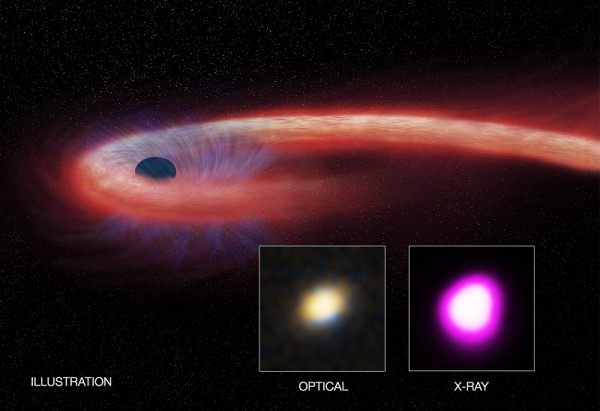By John Almirante, | February 14, 2017

Artist's conception of a tidal disruption event similar to the decade-long TDE that NASA reported of a supermassive black hole tearing apart a massive star. (YouTube)
A supermassive black hole has been consuming a star non-stop for ten years now. The black hole was detected because of the sudden increase in its X-ray brightness when it first started ingesting its target.
For a decade now, the star has been continuously losing its mass to the black hole which is named XJ1500+0154. The burst of intense X-rays that indicated the presence of the black hole, appeared suddenly ten years ago and has not yet dissipated.
Like Us on Facebook
According to the latest research, the decade-long disintegration of the star has set a new record for the longest tidal disruption event ever detected. A tidal disruption event takes place when an object like a star gets too close to a black hole and is torn apart by the intense gravitational field of the black hole.
According to a statement from NASA, while some of the matter ripped from the star is flung away, other portions are captured by the intense gravity and swirl into the black whole where it heats up and starts emitting X-rays. Scientists are able to detect those -rays which confirm the presence of the black hole.
Astronomers found XJ1500+0154 in 2005 with NASA's Chandra X-ray Observatory and Swift satellite together with ESA's XMM-Newton. The black hole was discovered while X-ray observatories were tracking a certain galaxy cluster.
The black hole was discovered due to an interesting feature of the cluster which is the interactions of its galaxies with the relatively dense gas in the region. When a sudden bright source of X-rays appeared behind that cluster of galaxies, the observatories imaged it relatively quickly.
Images of the source have been regularly captured since then. After a decade, astronomers have confirmed that the X-ray source, which peaked in brightness in 2008, is still emitting X-rays.
This can only mean that the source is a black hole that continues to rip apart a massive star. Scientists have not seen anything like this before.
Researchers led by Dacheng Lin from the University of New Hampshire in Durham, N.H published the study in the Feb. 6 issue of Nature Astronomy. They reported that the tidal disruption event had lasted ten times longer than any similar incident previously observed. According to NASA, scientists believe that the black hole, which is located in a galaxy 1.8 billion light-years from Earth, may be tearing apart the most massive star ever observed in a tidal disruption event.
-
Use of Coronavirus Pandemic Drones Raises Privacy Concerns: Drones Spread Fear, Local Officials Say

-
Coronavirus Hampers The Delivery Of Lockheed Martin F-35 Stealth Fighters For 2020

-
Instagram Speeds Up Plans to Add Account Memorialization Feature Due to COVID-19 Deaths

-
NASA: Perseverance Plans to Bring 'Mars Rock' to Earth in 2031

-
600 Dead And 3,000 In The Hospital as Iranians Believed Drinking High-Concentrations of Alcohol Can Cure The Coronavirus

-
600 Dead And 3,000 In The Hospital as Iranians Believed Drinking High-Concentrations of Alcohol Can Cure The Coronavirus

-
COVID-19: Doctors, Nurses Use Virtual Reality to Learn New Skills in Treating Coronavirus Patients







